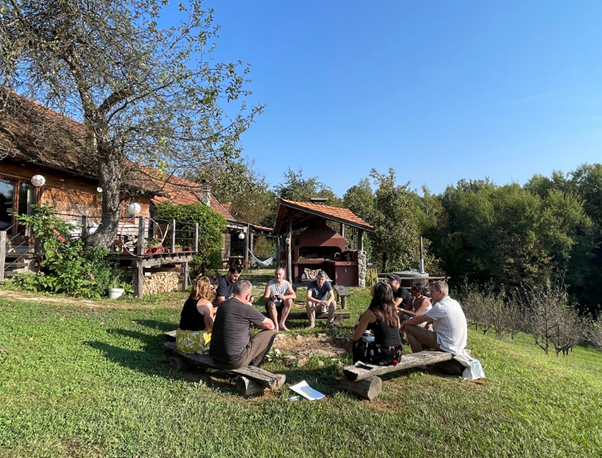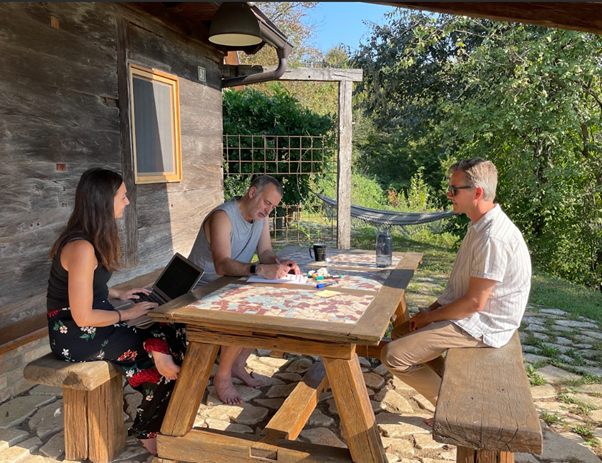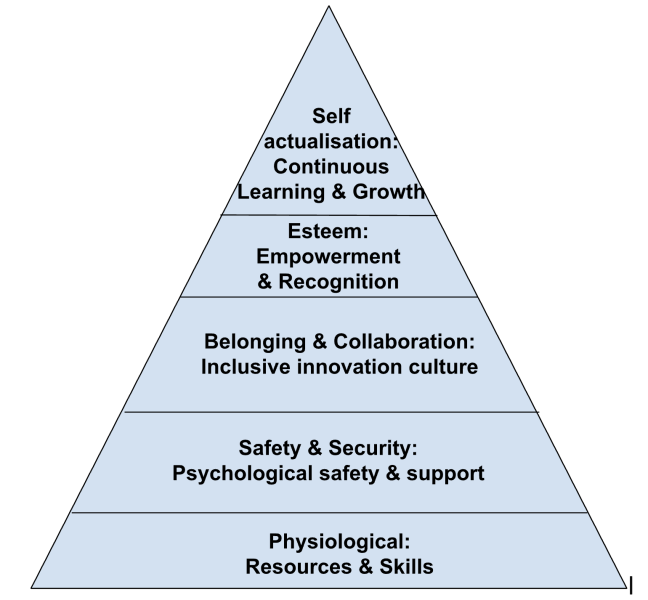Christian Graham12 Sep 2024
Innovation has always thrived at the intersection of seemingly unrelated ideas—but when we think of innovation within organizations, it’s not just the breakthrough technologies or the radical new processes that define success; it’s the nurturing of a culture where ideas flow freely, connect, and evolve into something greater.
Successful innovation cultures rely on a complex interplay of resources, safety, collaboration, empowerment and growth.
How do we embed an innovation culture?
At the Innovation for Impact Network's recent retreat in Croatia, we asked ourselves “How do we build such a culture in our organizations, ensuring that innovation becomes an embedded practice, not a fleeting experiment?”
The answer lies in a layered framework, reminiscent of Maslow’s hierarchy of needs, where each level represents a foundational requirement for creativity and progress. From securing the basic resources necessary to empower teams to fostering a sense of psychological safety and inclusion, this hierarchy is not linear but symbiotic—each layer reinforcing the others.
Physiological Level: The Resources of Innovation
At the base of any innovation ecosystem lies the essential resources—the raw materials that allow creativity to take root. Just as ecosystems depend on sunlight, water, and nutrients, an organization’s innovation potential is fuelled by access to funding, tools, and the right skillsets.
Investing in upskilling employees and securing sustainable funding streams isn’t just about preparation; it’s about creating the conditions for new ideas to germinate. Without these resources, innovation remains a distant possibility, cut off from the real world of practical experimentation and progress.
Level 1: Physiological - Resources and Skills
What it looks like:
|
Safety and Security: A Haven for Risk and Experimentation
Innovation thrives in an environment where risk-taking is not punished but encouraged. The great breakthroughs of history—from the lightbulb to the internet—did not emerge in spaces where failure was feared, but in places where it was embraced as a step on the path to success. Organizations need psychological safety to foster this kind of exploration. Leaders must model a culture of support, creating a space where employees feel safe to challenge the status quo and test new ideas. Without this layer of security, even the most capable teams will hesitate, paralyzed by the fear of getting it wrong.
Level 2 : Safety and Security - Psychological Safety and Support
What it looks like:
|
Belonging and Collaboration: The Power of Collective Creativity
Innovation is not a solitary endeavor; it’s a collective one. Ideas collide, merge, and evolve in the rich interplay between individuals. For organizations to innovate effectively, there must be a shared sense of purpose—an alignment between the vision of leadership and the insights bubbling up from every level of the workforce. This alignment, combined with top-down support and bottom-up creativity, ensures that innovation becomes embedded in the organizational culture, not just a lofty aspiration. The most groundbreaking ideas often come from unexpected places, but only if those places are connected to the larger whole.
Level 3 : Belonging and Collaboration - Inclusive Innovation Culture
What it looks like:
|
Esteem: Empowerment Through Recognition
Innovation isn’t just about giving people the tools and the space to create; it’s also about empowering them to take ownership of their contributions. When employees are recognized for their innovative thinking—whether through formal metrics like KPIs or informal celebrations of learning from failure—they become more engaged, more motivated, and more willing to push the boundaries. Recognition and empowerment feed the individual’s desire for achievement and elevate the collective will of the organization to keep moving forward. Without this esteem, innovation withers, starved of the recognition that drives it.
Level 4 : Esteem – Empowerment and Recognition
What it looks like:
|
Self-Actualization: The Continuous Evolution of Innovation
At the pinnacle of this hierarchy lies the ultimate goal: a culture where innovation is not an occasional burst of creativity but a continuous, self-sustaining process. In these environments, proactivity and humility coexist; individuals are constantly seeking out new challenges, while remaining open to learning from others. Innovation becomes integrated into the daily rhythm of work—an ever-present force that drives improvement and growth. This is the self-actualization of an innovative organization, where creativity flourishes naturally, and the boundaries of what’s possible are always being pushed a little further.
Level 5 : Self-Actualization – Continuous Learning and Growth
What it looks like:
|
Bringing that all together we get the Innovation Hierarchy of Needs:
If you'd like to know more about the Innovation for Impact network and Friends of the Earth's work on developing and fostering an organisational culture of innovation, please get in touch.
With grateful thanks to Anne (WWF), Anita (Care), Emma-Lee (UN WFP), Mari (Conservation International), Morten (Danish Refugee Council), Florian (Caritas Vienna), Julie (Amnesty USA), Veton & Andrew (Save the Children), Alicia (SOS Children’s Villages), Steve (International Medical Corps) and Lara Trikha of the Innovation for Impact Network for their ideas & contributions.




